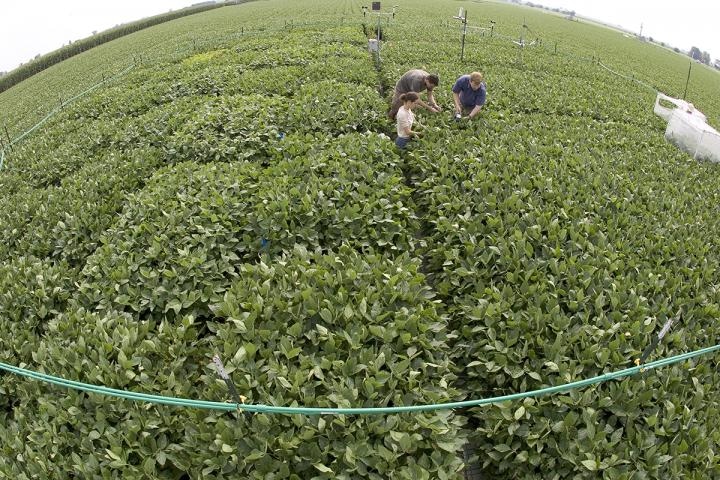Sep 6 2016
An eight-year study of soybeans grown outdoors in a carbon dioxide-rich atmosphere like that expected by 2050 has yielded a new and worrisome finding: Higher atmospheric CO2 concentrations will boost plant growth under ideal growing conditions, but drought – expected to worsen as the climate warms and rainfall patterns change – will outweigh those benefits and cause yield losses much sooner than anticipated.
 The Soybean Free Air Concentration Enrichment system at the University of Illinois allows researchers to simulate future atmospheric conditions to determine their effects on plants. Here, professor Andrew Leakey, right, works with research assistants Lindsey Heady and David Marshak in the SoyFACE facility. (CREDIT: Photo by Don Hamerman)
The Soybean Free Air Concentration Enrichment system at the University of Illinois allows researchers to simulate future atmospheric conditions to determine their effects on plants. Here, professor Andrew Leakey, right, works with research assistants Lindsey Heady and David Marshak in the SoyFACE facility. (CREDIT: Photo by Don Hamerman)
The new discovery, reported in the journal Nature Plants, contradicts a widely accepted hypothesis about how climate change will affect food production, said University of Illinois plant biology professor Andrew Leakey, who led the new research.
“If you read the most recent Intergovernmental Panel on Climate Change reports and if you read the scientific literature on the subject for the last 30 years, the concluding statement is nearly always that elevated carbon dioxide will ameliorate drought stress in crops,” Leakey said.
Numerous laboratory and field studies have supported this assessment: In many scenarios, elevated carbon dioxide acts as a fertilizer, boosting plant growth. Plants exposed to high CO2 also reduce the size of the pores in their leaves, lessening the exchange of gases with the atmosphere. This helps plants use less water from the soil.
Such findings strongly suggested that elevated CO2 would help plants better withstand drought, Leakey said.
“This was consistent with what we saw with our own experiments the first four years, the relatively wet years,” Leakey said. “But when the growing seasons were hot and dry, that pattern broke down.”
To make this discovery, Leakey and his colleagues relied on an unusual technology that enables them to simulate future climate conditions in actual farm fields. The Soybean Free Air Concentration Enrichment facility uses high-tech sensors to determine wind speed and direction, and a computer to regulate the release of gases to expose the crop plants to a given set of climate conditions.
Under hot and dry conditions at elevated CO2, the plants in the SoyFACE experiments used more, not less, water than those grown under current atmospheric conditions, the researchers found.
“What we think is happening is that early in the growing season, when the plant has enough water, it’s able to photosynthesize more as a result of the higher CO2 levels. It’s got more sugars to play with, it grows more, it creates all this extra leaf area,” Leakey said. “But when it gets dry, the plant has overextended itself, so later in the season it’s now using more water.”
Two other plant responses also contribute to the problem, the researchers found.
“At elevated CO2, there are changes in certain hormones the plant uses to signal between the roots and shoots,” Leakey said. “The plant becomes more sensitive to that signal at elevated CO2, and that causes photosynthesis to decline more in response to drought than it would do at ambient CO2 levels.”
Elevated CO2 and drought together also influence soybean’s ability to fix nitrogen through nodules formed on its roots. These nodules harbor bacteria that help the plant capture and convert atmospheric nitrogen into a form the plants can metabolize.
Under elevated CO2 and drought, the number of beneficial nodules on the soybean roots increases, Leakey said. “But what we find is that they put all these extra nodules on in relatively shallow soil layers. And the nodules don’t work well when they’re in dry soil.”
The new findings, from soybeans grown in one of the most productive regions of the planet, suggest climate-related declines in soybean yields will occur sooner than previously thought, Leakey said.
“All of the model predictions up to this point were assuming that in 2050, elevated CO2 was going to give us a 15 percent increase in yield over what we had at the beginning of this century,” he said. “And what we’re seeing is that as it gets hotter and drier, that number diminishes to zero. No gain.”
Leakey is an affiliate of the Carl R. Woese Institute for Genomic Biology at Illinois.
The U.S. Department of Agriculture’s National Institute of Food and Agriculture, the U.S. Department of Energy and the USDA Agricultural Research Service funded this research, along with a gift from David Sigman to the U. of I. at Urbana-Champaign.